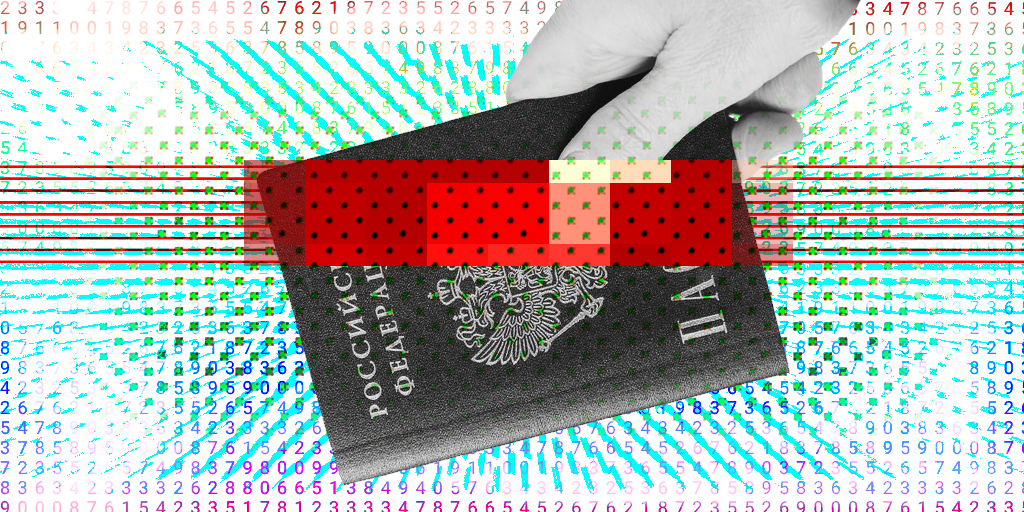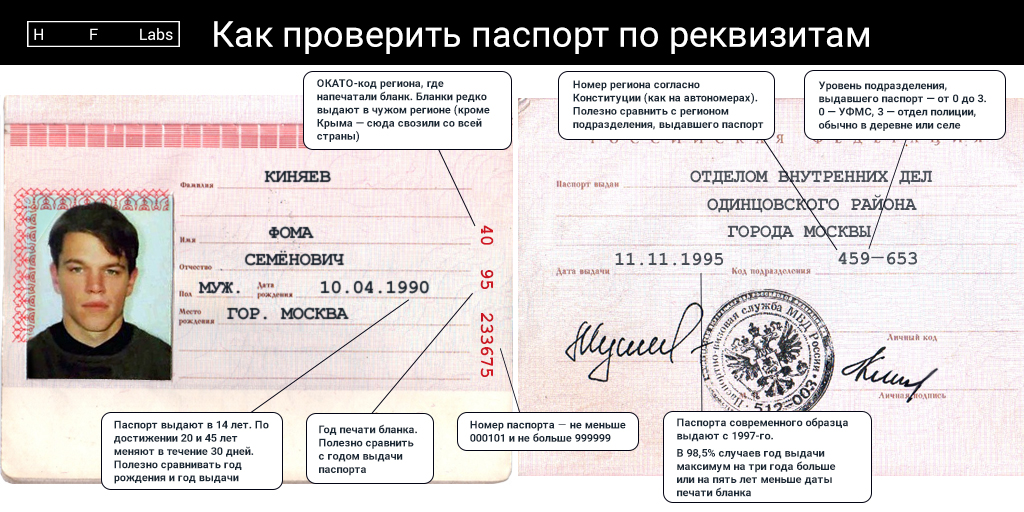
Passport details are not just a set of numbers; an information car is encoded in them. If you correctly decrypt and match the details, suspicious documents will instantly surface. For 14 years, HFLabs products have been checking customer data in banks, insurance, telecoms and other large businesses. I’ll tell you how we recognize errors in Russian passports.
And now we will meet our hero, who came to take a loan.

If you don’t know how to decrypt details at all, it looks quite solid
Full name
Name - this is an unformalized requisite of a passport. Even if “Abyrvalg Pshkhonevech” is written in the document, this may well be true - such parents. Therefore, looking at the name, determining the validity of the passport is a dubious undertaking.
Perhaps the only limitation is bill No. 1051801-6 , adopted in 2017. It prohibits the inclusion in the name of a child of numeric and alphabetic codes, as well as symbols. Also in the name you can not add ranks (lieutenant), positions and numbers. Also prohibited profanity and abbreviations. But all this is for children born in 2017 and later.
In any case, Foma Semenovich Kinyaev is a perfectly normal name. There is no cause for concern yet.
Passport Series
A good start is to check your passport series. It consists of four numbers.
The first two digits are the OKATO code of the region where the passport form was printed.
Passport series from the example - 40 95 . According to OKATO, region No. 40 is St. Petersburg. And the place of issue of the passport is the OVD of the Odintsovo district . Op, the first discrepancy.
However, this does not mean that the document is invalid. Sometimes forms from one region are issued in another, I’ll tell you more about this.
The third and fourth digits of the passport series is the year the form is printed.
From a series of passports from the example it is clear that the form was printed in the 95th year.
Sometimes, and not even so rarely, the declared year of printing the form is “younger” than the year the passport was issued. It looks wild, now I will explain.
The fact is that the regions and cities of Russia are completely different. The pace of issuing passports in them is fundamentally different. Every day in Moscow, new documents are issued by trucks, in blank villages blank forms have been lying for years.
In large cities, passport forms printed for a year sometimes end. Then new print at the expense of the future quota. Goznak approves the plan for several years in advance, so the forms are simply issued ahead of schedule. Naturally, keeping the numbering order.
We examined 100,000,000 passports and found a rule: for 98.5% of documents the date of issue falls in the range from “the year of printing the form - 5 years” to “the year of printing the form + 3 years”. Therefore, our algorithms make a stand if this ratio is violated.
In our example, the year the form was printed coincides with the year the passport was issued. It would seem that everything is fine, but let's not rush.
It is also useful to remember that the modern form was approved in 1997. Then they began to issue passports in exchange for Soviet ones. Therefore, the number consisting of the third and fourth digits of the series is in the ranges 97–99 or 00–22 (if checked in 2019 and taking into account that the form can be issued three years earlier than provided).
We return for example. The printing year of the form is 95th. Obviously, something is wrong here: in 1995, a form of this kind did not exist at all, everyone went with the Soviet.
room
Checking the passport by number is not so simple, but there are still clues.
With the format, everything is simple: normally it is six digits from 000101 to 999999. Uniqueness inside the series is mandatory.
The number actually refers to the form, not to the passport. That is, the requisite appears even before the form has turned into a passport. Goznak prints forms, it also ensures the uniqueness of the numbers.
There are legends that passports with the same numbers met. If this is possible, then only by mistake of Goznak and in exceptional cases. In real life, finding passports with the same numbers is almost impossible. If you find such, obviously something is wrong.
The numbers on the passports are “pass-through”, that is, they are not reset when switching to forms of the next year of manufacture.
Suppose, in the 97th year, forms 97 000101–97 003500 were printed. Then, in the 98th year, the numbering will continue from 98 003501, etc. After the blank with number 999999 is made, the next will be the number 000101 with the corresponding year of manufacture.
Passport Issuing Code
The code of the unit issuing the passport looks like a mysterious set of numbers in the format 999-999. In the meantime, this code is pretty formalized.
The first two digits are the number of the region where the unit issuing the passport is located. It is interesting that here the number is not taken from OKATO, as is the case with a series of passports - they use the more familiar subject number in the constitution . Approximately as on autonomies.
The discrepancy between the region where the form was printed and the branch region is not necessarily a mistake. Forms printed in one subject can go to another, and there they can turn into passports. Cases are relatively rare but occur.
True, there is a subject for whom it is generally pointless to compare a region on a form with a passport issuing region. Guess? Of course, this is the Crimea. When Russian passports were issued to residents of the peninsula, forms were taken from all over the country.
We saw Crimean passports printed on letterhead from the Kamchatka and Perm Territories, the Moscow Region and Tatarstan.
But the mismatch of the unit code to the name is a 100% problem marker. It is difficult to compare them automatically, but you can manually verify the authenticity of the passport at the slightest suspicion. As in the case when the region of the unit does not coincide with the region of printing the form.
The unit code in our example is 459-653 .
Subject number 45 under the constitution is Kurgan Oblast. Moreover, the region in the passport series is St. Petersburg. Suspicious mismatch, given the remoteness of the subjects.
In order to dispel doubts, we compare the unit code and its name: the Odintsovo district police department is very far from the Kurgan region. Failure after failure.
The third digit in the unit code indicates the level of that unit. Four levels:
- 0 - UFMS;
- 1 - GUVD or the Ministry of Internal Affairs of the region;
- 2 - ATC or ATS area or city;
- 3 - police station (usually in a village or village).
The third digit of the unit code from the example is 9 . And this is a clear mistake, because this level of units does not exist.
In April, we collected and opened a database of units issuing Russian passports . We use it to prompt units during input and reduce the number of errors.
Passport Issue Date
To check the validity of the passport, it is useful to compare the date of issue of the passport with the date of birth. A passport in Russia has been issued since the age of 14. Obviously, the difference between the date of birth and the date of issue should not be less than 14.
The guy from our example was born in the 90th, and the passport allegedly received in the 95th. At the age of five. By law, this is categorically impossible.
In addition, the passport is changed within 30 days after reaching a citizen of 20 and 45 years.
According to the passport in the example, a man was born in 1990, now he is 29 years old. At the same time, the year of issue of the document is the 95th, and should not be earlier than 2010 (1990 + 20 years). Even if there is no error in the details, the passport is expired. Its time to change.
I have written about the relationship between the year of issue of the passport and the year of printing of the form in the section “Passport Series”.

Check your passport for validity - in one picture
How does it all work for us?
We laid down the principles from the article in the Factor and Single Client products - systems use these rules to check the passport in the client base. Problems are more often associated with operator errors when entering data, but villains also come across.
Some checks were added recently: before, the systems looked at the details of passports separately, and now they compare them with each other, look for inconsistencies. In March, we released an update that accurately shows problems with the passport. Now data stewards are much easier to figure out what is wrong with the document.
| Props | Verdict before | Verdict now |
|---|---|---|
| 02 07 107536 | Wrong Series | The region from the series is not in OKATO
|
| 61 47 000 561 | Wrong Series | Series from the future |
| 61 17 000100 | Wrong number | Invalid number: allowed from 000101 to 999999 |
| Number: 45 07 107536
Unit Code: 020-512 | Correct document | Unit Code Conflict |
| Date of birth: 11.02. 1991
Date of issue of the passport: 15.02. 2007 | Correct document | The document is expired: the client is 28 years old, at 20 he should have received a new passport |
The article first appeared on the HFLabs blog .